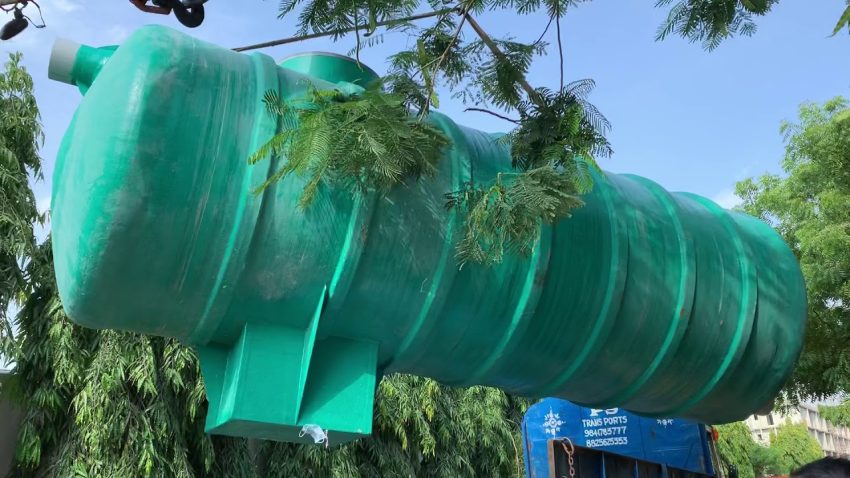A Bio Septic Tank is an important component of the wastewater management process. It helps to make waste management sustainable and effective, while also being environment-friendly.
In a Bio Septic Tank, the solid waste is broken down and separated from the liquid waste in separate chambers. The liquid is then recycled through an aerobic bacterial reaction, which leads to bi-products like treated water and carbon dioxide.
Less Sludge
The Benefits of a Bio Septic Tank
Unlike traditional septic tanks, the biological process used in a bio septic tank can reduce sludge and other solid waste. This makes them more efficient and eco-friendly than other options for treating wastewater.
Sludge is a common concern for homeowners with septic tanks. Sludge can clog the drains in the home and lead to other problems, such as backups and unpleasant odors.
It can also cause the leach field to clog up. If you are using a septic system, be sure to clean it regularly to avoid this problem.
The bacteria in the septic system are responsible for digesting waste and turning it into gas or reusable effluent. Despite this, the sludge in your septic tank can accumulate over time, leading to a need for pumping.
This accumulation of sludge can be difficult to detect. It is best to conduct a regular visual inspection of your septic tank.
One way to do this is by lowering a wooden pole into the primary or first chamber of your septic tank. This method is easy to perform and will give you an idea of where your sludge level is at.
Another option is to add a bio additive to your tank. This will help increase the amount of bacteria in the tank. This will allow the bacteria to work harder, digesting sludge more efficiently and quickly.
Adding a bio additive to your septic tank will help to improve the performance of your septic system and the health of your soil and plants. This can also help to reduce the odors and smells that are produced from your septic system.
A bio septic tank can also reduce the amount of chemicals used in the treatment process. Chemicals such as bleaches and root killers can kill off the bacteria that are necessary to treat waste and digest sludge.
Bio septic tanks use anaerobic digestion to break down organic waste and convert it into biogas or reusable water. They are also more cost-efficient than septic tanks.
Less Odor
One of the most noticeable advantages of a bio septic tank is the reduction of odor. This is due to the fact that it uses bacteria to decompose human waste. When compared to other systems that use traditional methods of disposal, a bio septic tank is much more effective and can significantly reduce the amount of odors produced by your home.
Odor can be caused by many different things, including a full septic tank or loose septic tank covers that are leaking. If you suspect that there is an issue with your septic tank, contact a professional to inspect it and determine the cause of the odor.
Regular treatment can help keep the bacterial balance in your system balanced and prevent foul odors. It also ensures that the septic tank is properly digested and liquefied, which helps to prevent blockages in your septic tank and drains.
The treatment can be purchased in various forms, including tablets or pods that can be flushed down your toilet each month. Some of these are more convenient than others, and some are designed for larger tanks or for homes with multiple occupants.
These pods contain billions of beneficial bacteria that break down the sludge and scum that can form in a septic tank. They’re moderately priced and non-toxic, which means that they’re safe for the environment and your family.
This septic tank treatment is available in tablet form for 1,000-gallon septic tanks, and it comes with a handy calendar on the top of each bottle to help you remember when it’s time to treat your septic tank again. This treatment can be used on both sewer and septic tanks, but it’s recommended that you use it on your septic tank more often than other treatments because it is more effective at breaking down sludge.
It’s also best to avoid using bleaches, solvents, and cleaning products on your septic tank. These can disrupt the bacterial balance and result in poor performance.
These septic tank treatment pods are made in the USA and are free of chemicals that could affect the environment or your health. They are easy to use and will break down grease, oil, fats, and other substances that can clog your drains.
Less Chemicals
A Bio Septic Tank is a system that helps homeowners manage their waste and reduce the amount of chemicals that enter the environment. The system breaks down waste into carbon-neutral biogas, which is used for energy. The system also allows you to reuse your wastewater for domestic purposes such as flushing the toilet, gardening, and other household uses.
The biodigester process is based on an anaerobic digestion process that occurs naturally in soils, lakes, and oceanic basin sediments. A biodigester septic tank is an artificial environment that makes it possible to replicate this natural process on your property, making sewage treatment more sustainable.
While a biodigester septic tank works to break down organic waste, it is important to avoid adding other products to the tank that could interfere with the natural process. For example, products that contain strong chemical-based drain cleaners should be avoided as they can damage the bacterial colonies in the system.
It is also important to avoid using products that contain disinfectants, sanitizers, and other cleaning agents that can be harmful to septic bacteria. These types of cleaners can contain highly concentrated bleaches or other disinfectants that are too harsh for the septic system.
These products can also be dangerous for the surrounding environment as they could leach into the ground and contaminate water sources. Many states ban these types of additives and their use can trigger liability issues if your groundwater becomes contaminated.
NT-MAX Septic Tank Treatment is a non-toxic, non-irritating and non-corrosive solution that is safe for use on your septic tank and drainfield. This product is designed to repopulate the septic system with thousands of trillions of naturally occurring bacteria that help break down waste.
Bacteria are naturally present in your septic system, but they must be constantly replenished to function efficiently. This is why NT-MAX Septic Tank Treatment can be used on your system regularly to help repopulate the system with the beneficial bacteria it needs to function properly.
Oftentimes, people mistakenly think that septic tanks need to be treated with chemicals or biological additives to keep them healthy. These types of additives are marketed as “bacterial boosters” or “biological enhancers.” While some septic systems benefit from the addition of biological or enzyme-based additives, others aren’t as affected. The bacteria or enzyme in an additive dose are usually only a fraction of what’s already in your septic system and therefore don’t have much effect on the breakdown of sewage. Introducing these types of additives into your septic system can also lead to clogging and may eventually cause the system to fail.
Less Waste
A bio septic tank is an environmentally friendly way to deal with your sewage waste. It can help reduce water pollution and improve your home’s efficiency while saving you money.
It also helps your community’s wastewater system to function more efficiently. The septic tank can filter waste from toilets, sinks, and drain lines, and the water is sent to a treatment facility where it is treated.
This process allows wastewater to be reused in the home for flushing toilets and for gardening. The water is rich in nutrients and the plants benefit from this extra food source.
Depending on the size of your tank, it may require a monthly pumping session to remove sludge and scum. This helps the bacteria in the septic tank break down these materials.
In addition, a weekly or bi-weekly application of NT-MAX septic tank treatment can also help reduce sludge and scum build-up. This product uses over 600 trillion bacteria per treatment to re-establish the natural bacterial colonies that can quickly digest waste.
These bacteria are naturally occurring in your septic tank’s fecal matter and can help the septic system keep up with its normal operations. They are also good at breaking down other organic material in the septic tank and in your drain lines.
One easy way to keep your septic tank’s bacterial population happy is to add a tablespoon of a dry yeast to the septic tank every month. The yeast has proteins called pectinase that help break down pectin, which is a type of plant cell wall.
It is also helpful to add a few handfuls of dried grass clippings into the tank each month, if available. This will help the bacteria to get more oxygen to feed on and it will also provide a natural mulch for the garden.
Another thing to consider is whether or not your septic tank has a filter kit installed. These kits can be purchased at most hardware stores and should be changed once every few years to ensure the tank is working properly.
You can also use a product called “Bio-Active” to keep the bacteria in your septic tank happy. These resemble common laundry or dishwasher pods and will help break down surface and bottom solids in the tank. This will help reduce sludge and scum in the tank and decrease odors.




